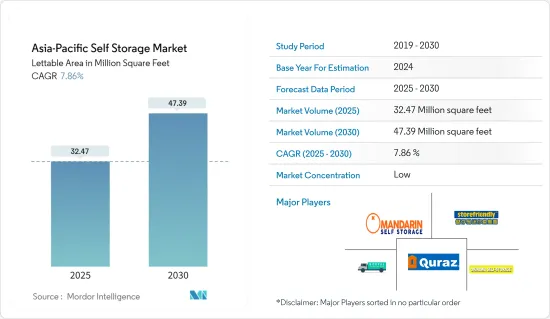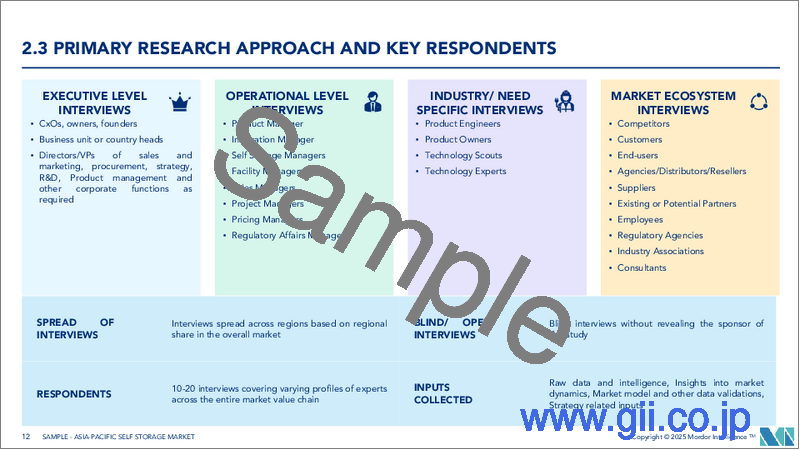|
|
市場調査レポート
商品コード
1687956
アジア太平洋地域のセルフストレージ:市場シェア分析、産業動向・統計、成長予測(2025年~2030年)Asia-Pacific Self Storage - Market Share Analysis, Industry Trends & Statistics, Growth Forecasts (2025 - 2030) |
||||||
カスタマイズ可能
適宜更新あり
|
|||||||
| アジア太平洋地域のセルフストレージ:市場シェア分析、産業動向・統計、成長予測(2025年~2030年) |
|
出版日: 2025年03月18日
発行: Mordor Intelligence
ページ情報: 英文 113 Pages
納期: 2~3営業日
|
全表示
- 概要
- 目次
アジア太平洋地域のセルフストレージ市場の賃貸可能面積は、2025年の3,247万平方フィートから2030年には4,739万平方フィートに拡大し、予測期間(2025-2030年)のCAGRは7.86%となる見込みです。

ビジネスの成長率は国によって異なるため、市場はかなり変遷しています。これは、所有権/不動産タイプ、地価、投資モデルなどのパラメーターに基づいています。
主なハイライト
- 特に香港、台湾、マレーシアなどの国々では、都市化、社会的認知度、小企業の拡大とともに、グラフに示すようにアジア太平洋地域の人口が増加しており、同地域のセルフストレージ施設の需要を押し上げていると分析されます。
- セルフストレージ施設の需要を促進するその他の要因としては、eコマースの拡大、リモートワークやフレキシブルなオフィススペースの増加、都市部への移住の進行、賃借人の急速な発展などが挙げられます。
- 同地域における居住空間のコスト増は、市場成長率に大きく寄与しています。例えば、香港の1人当たりの居住スペースは、米国のような新興経済諸国と比べてはるかに小さいです。さらに背景を説明すると、香港国勢調査統計局によると、2021年、香港の公共賃貸住宅入居者の平均居住スペースは1人当たり13.5平方メートルで、2017年から2021年まで、歴史的に13~13.5平方メートルで推移しています。
- 市街化可能/開発可能な土地は高価で希少です。地方自治体が開発を管理・統制する方法として、建築条例と計画規制があります。多くの都市では、開発規制法が何年も前に作られ、その効果について十分な実証的証拠もないまま、場当たり的に修正されています。
- COVID-19はいくつかの経済や産業に影響を与えたが、一部の産業は順調に拡大を続けています。セルフストレージ業界は、パンデミックによる深刻な影響は受けておらず、ストレージに対する消費者の需要とともに徐々に成長してきました。パンデミックの過去2年間は、個人の莫大な移転とオフィススペースの縮小が見られました。こうした状況から、セルフストレージの需要はかつてない勢いで増加しています。
APACセルフストレージ市場動向
消費者意識の高まりと人口密度が市場成長を牽引
- 厳しい経済状況の中、多くの企業が苦境に立たされているにもかかわらず、同地域ではセルフストレージ施設が順調に拡大しています。消費文化、eコマースの拡大、居住スペースの狭小化、人口増加により、個人および家族から身の回り品を保管するための安全で効率的な施設への需要が高まり、セルフストレージへの需要が急増しています。
- 都市化の進展は、市場成長を積極的に後押しする重要な要因のひとつです。都市人口の増加により、頻繁に引っ越しをするテナントが増え、都市部では居住エリアが狭く、割高になります。セルフストレージ・ビジネスは、アジアの人口が多く、豊かな地方都市に定着しています。裕福な地域は、住人が家の中でより多くの場所を占める贅沢品を購入する傾向が強いです。ワイン、アンティーク家具、電化製品など高価な品物を保存するために、空調管理された保管用コンテナなど、特殊な保管オプションへの需要が高まっています。
- この地域で平均住居面積が最も小さいのは、シンガポール、香港、東京です。シンガポールは人口密度が高く、平均住居面積は730平方フィートとアジアで最も小さいです。75%以上の住宅に収納スペースがないです。都市再開発庁(URA)の情報によると、シンガポールでは過去5年間で住宅価格が上昇しています。さらに、中国やインドなどでは人口密度が高まっており、予測期間中の市場成長率に寄与しています。セルフストレージ企業はアジア全域に進出しており、老朽化した施設の改築や新築の準備を進めています。さらに、市場の需要の変化に対応するため、長期保管利用者の需要が増加し、同地域での拡大が顕著になると予想されます。
アジア太平洋地域で最大の賃貸可能面積を持つ日本
- 日本では、セルフストレージ市場が消費者の間で、また新たな不動産投資商品として徐々に認知されるようになり、ここ数年の市場拡大につながりました。家具や貴重品の住まいの分散化、非常時や地震などの自然災害に備えたサバイバルフードの備蓄、セルフストレージ業界への注目も高まっています。
- 日本におけるセルフストレージの事業区分は、トランクルーム、レンタル収納スペース、レンタルコンテナの3つがあります。まず、倉庫業法に基づいて運営されるいわゆる「トランクルーム」。これらの事業者は、保管した物件の代金を顧客に返済しなければならないです。次に「レンタル収納スペース」と呼ばれる、ビルや専用施設に設置された部屋を賃貸する形態。最後に「レンタルコンテナ」と呼ばれる、主に屋外に設置された貸しコンテナです。
- さらに、B to Bの業態ばかりに目を向けていた倉庫業が、新たな業態として一般消費者をターゲットにしたトランクルーム事業へと業容を拡大しています。さらに、トランクルーム・セルフストレージ施設は、国内の大手市場ベンダーが革新的なソリューションを提供し、大きな支持を集めています。セルフストレージ施設は日本では「トランクルーム」と呼ばれています。
- 例えば、キュラーズが2021年11月に実施した「年間供給量調査」に基づく最新の推定によると、トランクルーム市場(屋内・屋外を含む)は670億円と大幅に拡大し、過去10年間で倍増しています。また、同調査によると、テレワークやオンライン学習の急速な浸透、在宅ライフスタイルの定着など、生活環境の変化により新たな収納ニーズが発生しています。
アジア太平洋地域のセルフストレージ業界の概要
アジア太平洋地域のセルフストレージ市場は、日本、シンガポール、シンガポール、マレーシアなどの国に多くのベンダーが存在するため、非常に断片化されています。インドのような新興国はニッチ市場を占めており、新規参入が見られます。さまざまなプレーヤーが新しい施設を通じて新しい地域でのプレゼンスを拡大し続けています。
- 2022年5月- 香港では、StorHubが運営する4番目のセルフストレージ施設が営業を開始しました。このストレージ施設は、長沙湾(チュンシャワン)のPrecious Industrial Centre(プレシャス・インダストリアル・センター)の18番Cheung Yu Street(チュンユー・ストリート)にあり、この地域に住む地元の人々に信頼できる安全なストレージオプションを提供できます。
- 2022年3月-QurazCo.Ltd.は、消費者が自宅にいながらスマートフォンで荷物の出し入れができる新サービス「QurazHomeデリバリーサポート」を全店舗で開始すると発表しました。「キュラーズ宅配サポート」は、多くのお客様のご要望にお応えし、トランクルームの利便性を高める新サービスです。このサービスを利用することで、段ボールやゴルフバッグ、スーツケースなどの大きな荷物を、自宅にいながらトランクルームから取り出すことが可能になります。
その他の特典:
- エクセル形式の市場予測(ME)シート
- 3ヶ月間のアナリスト・サポート
目次
第1章 イントロダクション
- 調査の前提条件と市場定義
- 調査範囲
第2章 調査手法
第3章 エグゼクティブサマリー
第4章 市場洞察
- 市場概要
- 業界の魅力度-ポーターのファイブフォース分析
- 供給企業の交渉力
- 買い手の交渉力
- 新規参入業者の脅威
- 代替品の脅威
- 競争企業間の敵対関係の強さ
- COVID-19の市場への影響評価
第5章 市場力学
- 市場促進要因
- 消費者意識の高まりと人口密度
- 市場抑制要因
- 施設を建設するための利用可能なスペースの不足
第6章 市場セグメンテーション
- エンドユーザー別
- 個人
- ビジネス
- 国別
- 日本
- 中国
- 香港
- 台湾
- シンガポール
- マレーシア
第7章 競合情勢
- 企業プロファイル
- Mandarin Self-storage Pte Ltd
- Store Friendly Self-storage Group Ltd(GSC)
- Boxful Limited
- Quraz Ltd
- Okinawa Self-storage
- StorHub Self-storage
- UD Self-storage
- Extra Space Asia
- Far East Organization(Store Y Self Storage)
- Storage King Group
第8章 投資分析
第9章 市場の将来
The Asia-Pacific Self Storage Market size in terms of lettable area is expected to grow from 32.47 million square feet in 2025 to 47.39 million square feet by 2030, at a CAGR of 7.86% during the forecast period (2025-2030).

The market is transitioning considerably since the business grows at different rates in different countries. This is based on parameters such as ownership/property type, land rate, and investment models.
Key Highlights
- The growing population in Asia-Pacific, as indicated in the graph alongside the urbanization, public awareness, and the expansion of small enterprises, especially in countries like Hong Kong, Taiwan, Malaysia, and so on, are analyzed to boost the demand for self-storage facilities in the region.
- Additional factors driving the demand for self-storage facilities include e-commerce expansion, increased remote working and flexible office space, ongoing migration into cities, and the rapid development of renters.
- The growing living space costs in the region significantly contribute to the market growth rate. For instance, the living space per person in Hong Kong is much less compared to developed economies like the United States. To provide more context, according to the Census and Statistics Department of Hong Kong, in 2021, the average living space of public rental housing tenants in Hong Kong was 13.5 sq. m per person, and it has historically remained between 13 to 13.5 sq. m from 2017 to 2021.
- Urbanizable/developable land is both expensive and scarce. Building bye-laws and planning regulations are two ways that local governments control and manage development. Many cities have development control laws created years ago and have been modified haphazardly without enough empirical proof of their effects.
- COVID-19 has impacted several economies and industries; however, some industries continue to expand steadily. The self-storage industry has not been severely affected by the pandemic and has grown gradually with the consumer demand for storage. The past two years of the pandemic have seen enormous individual relocations and office space reductions. Due to this circumstance, the demand for self-storage has increased at an unprecedented rate.
APAC Self Storage Market Trends
Rising Consumerism and Population Density is Driving the Market Growth
- Self-storage facilities are expanding steadily in the region, despite many businesses struggling during difficult economic times. Demand for self-storage is surging as a culture of consumerism, the expansion of e-commerce, the constricting availability of living space, and the growing population drive demand from individuals and families for safe and efficient facilities for storing personal items.
- Growing urbanization is one of the significant factors positively driving market growth. Growing urban populations result in more tenants who move around frequently and smaller, more expensive living areas in cities. Self-storage businesses have established themselves in Asia's more populous and affluent regional cities. Affluent neighborhoods tend to have a greater propensity for inhabitants to buy luxuries that take up more room in their homes. There is an increasing demand for specialized storage options, such as climate-controlled storage containers, to preserve expensive goods such as wine, antique furniture, or electronics.
- In the region, the smallest average dwelling sizes are found in Singapore, Hong Kong, and Tokyo. Singapore has a dense population and the smallest dwelling sizes in Asia, with an average of 730 square feet. More than 75% of residential units lack a storage area. According to information from the Urban Redevelopment Authority (URA), housing prices have increased in Singapore over the last five years. Furthermore, the growing population density in countries such as China and India contributes to the market growth rate during the forecast period. Self-storage companies have expanded all over Asia, remodeling aging facilities and preparing brand-new construction. Additionally, to meet the market's shifting demands, the nation is expected to experience an increase in demand for long-term storage users, resulting in notable expansions in the region.
Japan to have the Largest Lettable Area in the Asia Pacific Region
- In Japan, the self-storage market has gradually gained recognition among consumers and as a new real estate investment product, leading to market expansion in the past few years. Decentralizing the housing of furniture and valuables, stockpiling survival food for emergency and natural disasters such as earthquakes, and attention to the industry have intensified with self-storage.
- There are three self-storage business classifications in Japan: trunk room, rental-storage space, and rental container. First is the so-called "trunk room" managed under the Warehousing Business Act. These operators must repay customers for the stored property. Next, is a class called a "rental-storage space" that uses rooms set up in a building or specialized facility for leasing. The last class is called a "rental container," mainly set up outdoors for rental.
- Furthermore, the warehousing industry, which focused only on a business-to-business format, has expanded its business to the trunk-room business to target the general consumer as a new business type. Additionally, trunk room self-storage facilities are gaining significant traction, with the leading market vendors in the country offering innovative solutions. Self-storage facilities are called "trunk rooms" in Japan.
- For instance, according to the latest estimates based on the Annual Supply Survey conducted in November 2021 by Quraz, the storage room market (including indoor and outdoor) has expanded significantly to JPY 67 billion, doubling over the past ten years. Furthermore, according to the survey, new storage needs have arisen due to changes in the living environment, such as the rapid penetration of telework and online learning and the ongoing stay-at-home lifestyle.
APAC Self Storage Industry Overview
The Asian-Pacific self-storage market is highly fragmented due to the presence of many vendors in countries such as Japan, Singapore, Singapore, and Malaysia. Emerging countries like India account for a niche market, witnessing new entrants. Different players continue to expand their presence in new regions through new facilities.
- May 2022 - In Hong Kong, the fourth self-storage facility operated by StorHub began its operations. The storage facility could offer trustworthy and safe storage options to locals living in the area at Precious Industrial Centre, No. 18 Cheung Yu Street, in Cheung Sha Wan.
- March 2022 - QurazCo. Ltd announced a new service, "QurazHome Delivery Support," at all stores that could allow consumers to put in and take out luggage with their smartphone while staying home. "QurazHome Delivery Support" is a new service that responds to many customers' requests and enhances trunk rooms' convenience. With this service, it could be possible to take large items such as cardboard boxes, golf bags, and suitcases from the trunk room that consumers use while at home.
Additional Benefits:
- The market estimate (ME) sheet in Excel format
- 3 months of analyst support
TABLE OF CONTENTS
1 INTRODUCTION
- 1.1 Study Assumptions and Market Definition
- 1.2 Scope of the Study
2 RESEARCH METHODOLOGY
3 EXECUTIVE SUMMARY
4 MARKET INSIGHTS
- 4.1 Market Overview
- 4.2 Industry Attractiveness - Porters Five Forces Analysis
- 4.2.1 Bargaining Power of Suppliers
- 4.2.2 Bargaining Power of Buyers
- 4.2.3 Threat of New Entrants
- 4.2.4 Threat of Substitute Products
- 4.2.5 Intensity of Competitive Rivalry
- 4.3 Assessment of Impact of COVID-19 on the Market
5 MARKET DYNAMICS
- 5.1 Market Drivers
- 5.1.1 Rising Consumerism and Population Density
- 5.2 Market Restraints
- 5.2.1 Lack of Available Space to Build the Facilities
6 MARKET SEGMENTATION
- 6.1 By End User
- 6.1.1 Personal
- 6.1.2 Business
- 6.2 By Country
- 6.2.1 Japan
- 6.2.2 China
- 6.2.3 Hong Kong
- 6.2.4 Taiwan
- 6.2.5 Singapore
- 6.2.6 Malaysia
7 COMPETITIVE LANDSCAPE
- 7.1 Company Profiles
- 7.1.1 Mandarin Self-storage Pte Ltd
- 7.1.2 Store Friendly Self-storage Group Ltd (GSC)
- 7.1.3 Boxful Limited
- 7.1.4 Quraz Ltd
- 7.1.5 Okinawa Self-storage
- 7.1.6 StorHub Self-storage
- 7.1.7 UD Self-storage
- 7.1.8 Extra Space Asia
- 7.1.9 Far East Organization (Store Y Self Storage)
- 7.1.10 Storage King Group






